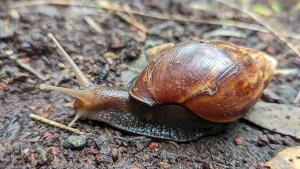VNR: Stressed snails and slugs may spread rat lungworm through slime
University of Hawaiʻi at MānoaPostdoctoral Researcher, School of Ocean and Earth Science and Technology
Robert H. Cowie, 808-956-4909
Research Professor, School of Ocean and Earth Science and Technology
Link: https://spaces.hightail.com/receive/b1x6KfsKpu
Can humans become infected with the rat lungworm parasite from snail slime, if an infected snail or slug leaves slime on a lettuce leaf? That is the question University of Hawaiʻi at Mānoa researchers set out to answer in a study published in One Health.
Randi Rollins, Matthew Medeiros and Robert Cowie of UH Mānoa’s Pacific Biosciences Research Center, found that rat lungworm larvae (the third larval stage worms, which are the only ones that are infectious to humans and other animals) are present in snail slime when the snails are exposed to stress. The findings indicated that 13% of stressed snails released larvae, compared to none in a non-stressed control group.
Rat lungworm is a parasite with a development that cycles between snails and rats. Humans can become infected when they ingest (accidentally or intentionally) a raw or undercooked snail. However, alternative transmission pathways have also been considered, such as larvae present in slime trails left on produce, or slime on a child’s hand after playing with a snail.
“Although the number of larvae you would have to ingest to cause illness is unknown, the numbers present in slime may be sufficient, as snails release tens, hundreds or thousands (we found >4,000 in the slime of one snail) of larvae,” said Rollins. “However, the larvae cannot survive desiccation (removal of moisture), so snail slime will not be a risk after it dries.”
Exercise caution
The study's implications for public health are important, especially in Hawaiʻi, where rat lungworm is present across the islands. Although reported cases of rat lungworm disease are relatively rare, it can cause devastating effects on patients and their families. The researchers highlighted the importance of exercising caution when handling snails and slugs, inspecting and washing produce, and being cautious with store-bought salads that may be contaminated with snail slime or even the snails or slugs themselves.
“The study has important implications for public health, especially as the increasing frequency and intensity of environmental stressors are features of anthropogenic global change,” said Cowie. “It also aligns with the holistic concept of One Health, which recognizes the interconnectedness of human, animal and environmental health.”
How does stress impact snails?
Researchers hypothesized that host stress influences the release of rat lungworm larvae from snails, and tested this prediction by subjecting wild-caught, naturally infected snails (the semi-slug Parmarion martensi) to a variety of stressors, including heat, snail/slug bait (a pesticide) and physical disturbance, as well as including a non-stressed “control” group of snails for comparison.
“This study underscores the role of host stress in the transmission of zoonotic disease, which is particularly pertinent given that approximately 60% of infectious diseases that emerged between 1940 and 2004 have been attributed to transmission from animals to humans,” said Rollins. “Moreover, such zoonoses, as animal-to-human-transmitted diseases are known, are predicted to increase with continued exploitation of wildlife, unsustainable farming practices and land use, and climate change, which will reshuffle environments and alter host stressor regimes.”
Researchers were surprised at the association between stress and larval release, emphasizing the need for further research to understand different stress types and their effects on snail physiology and immunology. This association with stress has broader implications for the transmission of other zoonotic diseases, as the world becomes an increasingly stressful place.
Washing produce, to dislodge and remove any snails or snail slime, is recommended to prevent possible infection. Larvae cannot withstand extreme temperatures, so cooking or freezing produce will also prevent infection. Do not handle snails or slugs with bare hands. Use gloves, or any other material/tool to keep a barrier between your skin and the snail/slime.
This work was supported by George F. Straub Trust of the Hawaiʻi Community Foundation (grant number 20CON-102164) and by a UH Graduate Student Organization research grant.
VIDEO: b-roll (1 minute, 11 seconds)
0:00-1:11 - video and photos of snails and rat lungworm larvae
SOUNDBITES:
Randi Rollins, UH Mānoa Pacific Biosciences Research Center postdoctoral researcher (11 seconds)
“We found that when snails are stressed, so when they are subjected to environmental stressors, they can release the rat lungworm parasite into the slime.”
Rollins (14 seconds)
“The things I really recommend to keep you safe from rat lungworm disease is first and foremost wash your produce, make sure it’s clean. If you’re going to handle snails don’t do it barehanded, wear some gloves.”
Rollins (11 seconds)
“As soon as the parasite dries up it is no longer infectious. So, if that slime that's on your produce dries, it's no longer a risk to cause rat lungworm disease.”


